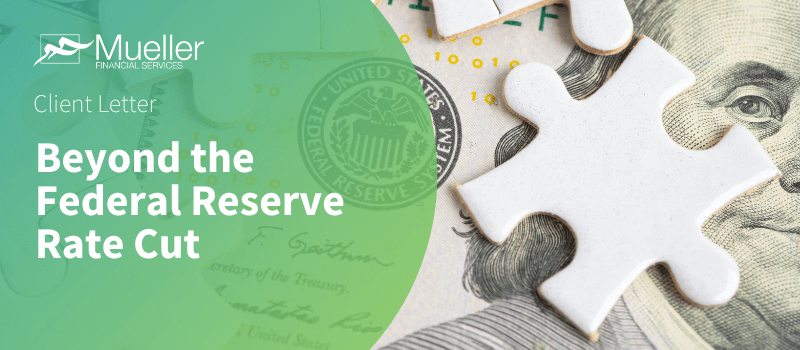Dear Valued Investor,
Every so often Washington likes to remind us how hard it can be to get things accomplished. The most recent example is the debt ceiling—the amount Congress can borrow to pay its bills. It seems like we have this debate every few years and in the end a deal is made, which is just what happened this time. Considering equity markets never really reacted to the drama, perhaps this is a good reminder that focusing on long-term objectives is the best strategy, even amid a fair amount of market noise.
With the debt ceiling drama behind us, markets will likely return their attention to topics such as inflation, the health of the economy, and the Federal Reserve (Fed)—who is scheduled to meet June 14-15. Expectations are that they will not raise short-term interest rates for the first time in 10 meetings. The Fed has done a lot of heavy lifting already—raising short-term interest rates by 5% in just over a year. Since rate hikes tend to have a long and variable lag, the Fed wants to see how those rate hikes more fully flow through the economy before its next move.
The Fed’s goal has been to elevate the fed funds rate and make the cost of borrowing money prohibitively expensive, to slow aggregate demand. While this has exposed some cracks in the regional banking sector, it should allow inflationary pressures to abate. But then what? After winning its fight with inflation, the Fed is expected to start cutting rates early next year. Just as the aggressive rate-hiking cycle took Treasury yields higher, interest rate cuts will take Treasury (and other bond market) yields lower. Both lower inflation and an end to rate increases could be welcome news for core bonds, especially intermediate core bonds, which have tended to perform well after rate-hiking campaigns. Investors may be better served by locking in these higher yields before they’re gone.
Only time will tell, but it feels like we’re finally on a path to lower interest rates and the end of this inflationary cycle. Of course there will be other challenges to deal with, that’s just the dynamic nature of the market. But in the meantime, returning to the familiar—lower rates and the end of inflation—is something we can all rally around.
As always, please reach out to your financial advisor with questions.
Sincerely,
Lawrence Gillum, CFA
Chief Fixed Income Strategist
LPL Research
muellerfinancial@muellersolutions.com
847.888.8600
Mueller Financial Services
https://www.muellerfinancialsolutions.com
This material is for general information only and is not intended to provide specific advice or recommendations for any individual. There is no assurance that the views or strategies discussed are suitable for all investors or will yield positive outcomes. Investing involves risks including possible loss of principal. Any economic forecasts set forth may not develop as predicted and are subject to change.
References to markets, asset classes, and sectors are generally regarding the corresponding market index. Indexes are unmanaged statistical composites and cannot be invested into directly. Index performance is not indicative of the performance of any investment and do not reflect fees, expenses, or sales charges. All performance referenced is historical and is no guarantee of future results.
All index data from FactSet.
The Standard & Poor’s 500 Index (S&P500) is a capitalization-weighted index of 500 stocks designed to measure performance of the broad domestic economy through changes in the aggregate market value of 500 stocks representing all major industries.
All information is believed to be from reliable sources; however, LPL Financial makes no representation as to its completeness or accuracy.
Bonds are subject to market and interest rate risk if sold prior to maturity. Bond values will decline as interest rates rise and bonds are subject to availability and change in price.
There is no guarantee that a diversified portfolio will enhance overall returns or outperform a non-diversified portfolio. Diversification does not protect against market risk.
Past performance does not guarantee future results.
Asset allocation does not ensure a profit or protect against a loss.
For a list of descriptions of the indexes and economic terms referenced, please visit our website at lplresearch.com/definitions.
This research material has been prepared by LPL Financial LLC.
Securities and advisory services offered through LPL Financial (LPL), a registered investment advisor and broker-dealer (member FINRA/SIPC).
Insurance products are offered through LPL or its licensed affiliates. To the extent you are receiving investment advice from a separately registered independent investment advisor that is not an LPL affiliate, please note LPL makes no representation with respect to such entity.
Not Insured by FDIC/NCUA or Any Other Government Agency | Not Bank/Credit Union Guaranteed
Not Bank/Credit Union Deposits or Obligations | May Lose Value
RES-1547804-0523 | For Public Use | Tracking # 1-05372704 (Exp.06/24)
Related Insights

November 6, 2024
Donald Trump Elected 47th President of the United States of America
ShareDonald Trump was elected the 47th president of the United States, defeating Vice President Kamala Harris thanks to strong performance …
Read More navigate_next
October 2, 2024
Beyond the Federal Reserve Rate Cuts
ShareFinally! For the first time in more than four years, on September 18, the Federal Reserve (Fed) cut interest rates. …
Read More navigate_next